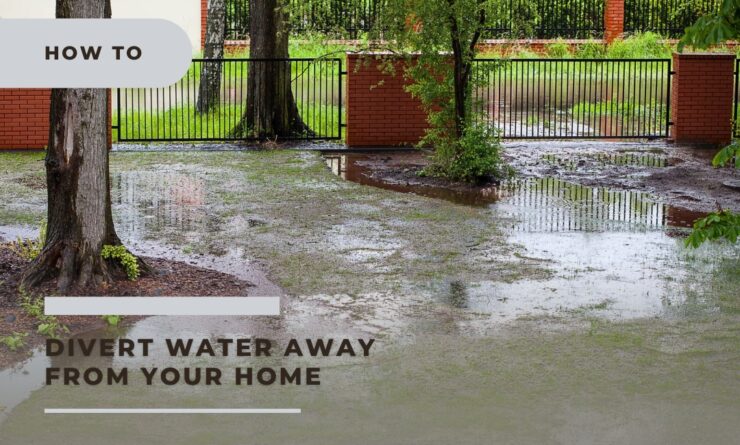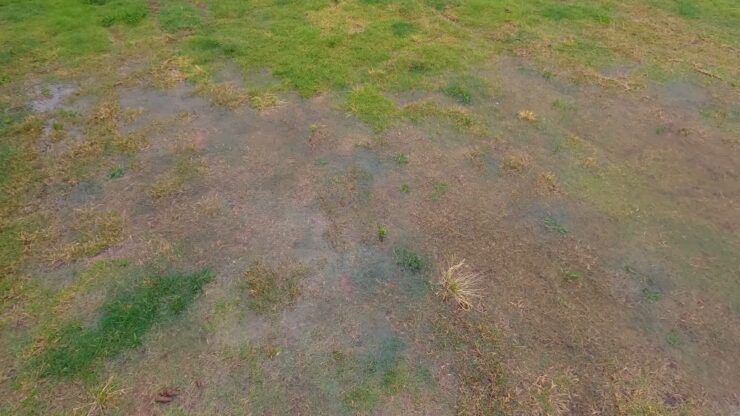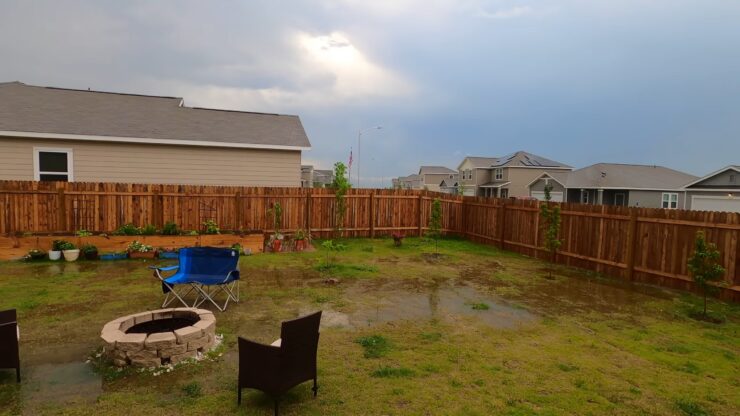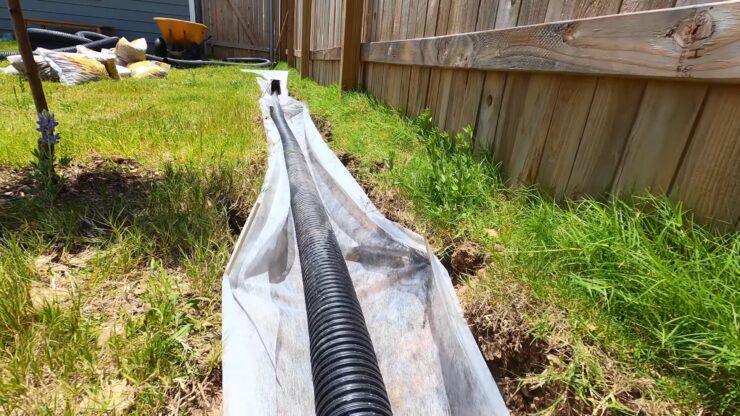Is your yard resembling a lakeside property without the actual lake and view? If puddles form in your garden after a downpour, you might be facing a water drainage dilemma. Overlooking this can be tempting, but remember, a moist landscape can lead to a damp basement, escalating to water damage and mold growth. The solution? Guide the water away from your dwelling.
Wondering if your home has a drainage challenge? Let’s explore the indicators of water drainage problems, the potential hazards of neglecting them, and strategies to channel water away from your residence.
Signs You Might Have a Drainage Problem
Sometimes, after a heavy rain, your yard might scream “drainage problem” with its mini-lakes and marshy patches. But at other times, the signs can be subtle. Here’s a checklist to help you spot potential drainage issues, indicating it’s time to steer water away from your home:
- Gutters spilling over
- Mulch being swept away
- Persistently wet lawn
- Musty or damp smells
- Marks of water damage
- White powdery residue or walls in the basement showing cracks and peeling
Spotted any of these? They’re red flags signaling bigger threats to your home’s health and integrity. Don’t wait; address them!
Dangers of Inadequate Water Drainage
Water, while essential, can be a homeowner’s nemesis when not managed properly. From minor inconveniences to major financial setbacks, water drainage issues can escalate quickly. If you’ve spotted signs of drainage troubles, here’s why you should act promptly:
- Basement Woes: Water pooling around your home can lead to leaky basements or even worse, full-blown floods. Such incidents can be a homeowner’s worst nightmare, burning a deep hole in the pocket due to extensive damages.
- Mold Menace: Dampness is mold’s best friend. With drainage issues, water can seep through the foundation, making its way into basements. Combine this with organic materials like cardboard, and you’ve got a recipe for mold growth. Beyond property damage, mold can pose serious health risks, with its spores potentially spreading throughout the home.
- Mosquito Magnet: Stagnant water is a breeding ground for mosquitoes. These pesky insects aren’t just annoying; they can also be carriers of various diseases.
- Plant Peril: While plants love water, there’s a limit. Poor drainage can oversaturate the soil, causing plants to suffocate and eventually perish.
- Foundation Fears: Water intrusion can wreak havoc on a building’s foundation. The constant cycle of water seepage, followed by freezing in colder months, can lead to the foundation expanding and contracting, compromising its structural integrity.
Guide to Steering Water Away from Your Home
Water-related damages can be both a homeowner’s nightmare and a heavy hit to the wallet. To safeguard your home from potential water troubles, here are some effective strategies to channel water away and dodge those hefty repair bills:
- Gutter Maintenance: Gutters are your home’s first line of defense against water damage. Ensure they’re clean and free from debris. When functioning optimally, they’ll guide water away from your home. Neglected gutters can lead to water spilling close to your foundation.
- Downspout Extension: A simple yet effective solution. Extend your downspouts to ensure they direct water at least 6 feet away from your home’s foundation. This small investment can make a big difference.
- Rain Barrel Setup: If extending downspouts isn’t feasible, consider a rain barrel. It captures runoff from your roof, storing it for later use like watering plants. This not only keeps excess water at bay but can also trim your water bills.
- Landscaping Grade: Ensure your yard slopes away from your home. A common culprit behind basement flooding is improper yard grading. Addressing minor grading issues can prevent major water woes.
- Rain Garden Creation: These gardens are both functional and aesthetically pleasing. Positioned about 10 feet from your home, they utilize plants that flourish in wet conditions and layers of rocks and soil to minimize runoff.
- French Drain Installation: Effective for addressing groundwater issues, French drains involve digging a trench, lining it with fabric and gravel, and placing a drainpipe. It’s a labor-intensive task, so consider professional help.
- Sump Pump Setup: For homes vulnerable to basement flooding, sump pumps can be invaluable. They’re designed to combat significant flooding. While they come with an upfront cost, they can save you from more expensive damages in the future.
- Seek Professional Help: Despite your best efforts, extreme weather or malfunctioning appliances can still lead to water damage. In such cases, it’s wise to consult a professional restoration company specializing in water and mold issues.
In essence, proactive measures can save you from the stress and costs associated with water damage. Invest time and effort now to protect your home in the long run.
FAQ
How do I stop water from flowing into my yard?
To prevent water from flowing into your yard, consider the following steps:
- Ensure your yard is graded away from your home.
- Install barriers like retaining walls or berms.
- Plant water-resistant plants or create a rain garden.
- Clean and maintain gutters and downspouts regularly.
- Use downspout extenders to direct water away from your home.
How do you redirect water away from the foundation?
Redirecting water away from the foundation can be achieved by:
- Properly grading the landscape around the foundation.
- Installing extended downspouts.
- Using a French drain system.
- Applying waterproofing to your foundation.
- Installing a sump pump in basements prone to flooding.
What is a French drain system?
A French drain is a trench filled with gravel or rock containing a perforated pipe that redirects surface water and groundwater away from an area, such as a home’s foundation.
Are French drains expensive?
The cost of a French drain depends on its length, depth, and location. On average, homeowners might spend between $2,800 to $6,500 for a French drain installation. However, prices can vary based on regional labor costs and materials.
What are the disadvantages of a French drain?
Some disadvantages of a French drain include:
- Potential for clogging over time.
- Regular maintenance is required to keep it functional.
- Can be labor-intensive and costly to install.
- Might redirect water to a neighboring property if not installed correctly.
Are French drains a good idea?
Yes, French drains can be an effective solution for preventing water-related issues, especially in areas prone to heavy rainfall or if the home is situated in a low-lying area. They help in redirecting water away from structures, reducing the risk of foundation damage.
What is better than a French drain?
While French drains are popular, alternatives like curtain drains, swales, or sump pumps might be more suitable depending on the specific water drainage issue and landscape design.
How many years does a French drain last?
A well-maintained French drain can last anywhere from 20 to 30 years. However, its lifespan can be influenced by factors like soil type, debris accumulation, and the quality of materials used.
Why not to use a French drain?
While French drains can be effective, they might not be suitable if:
- The property has heavy clay soil, which can clog the system.
- The drain might redirect water to a neighboring property.
- There’s limited space for proper installation.
- The homeowner is looking for a low-maintenance solution.
In Conclusion
Water, in its rightful place, is a blessing, but when mismanaged, it becomes a formidable adversary to any homeowner. Recognizing the signs of drainage issues and acting promptly can be the difference between a serene home and a costly disaster.
By implementing the strategies outlined above, you not only protect your home’s structural integrity but also ensure a safe and healthy environment for its inhabitants.
Remember, it’s always better to be proactive than reactive. Safeguard your home, your sanctuary, from the unpredictable whims of water. Your future self will thank you.


















